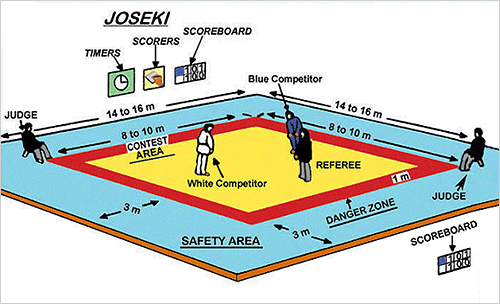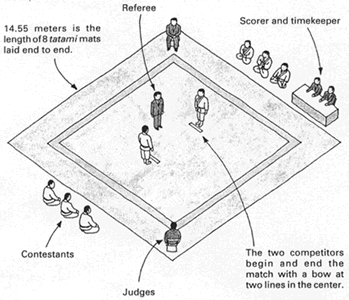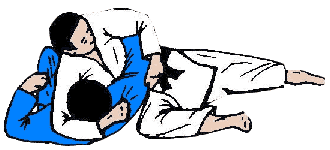Judo matches are fought between two people on a square mat measuring between 8 to 10 meters per side. There is one head referee and two assistant referees. Any one of 67 throwing techniques and 29 grappling techniques may be used to win.
Read more about the IJF Referee
Rules
![]()


A diagram of a judo mat. (from Illustrated Martial
Arts and Sports in Japan, published by Japan Travel Bureau;
illustrator, Masaki Matsushita)
Scores are awarded for various techniques, the highest being ippon, when you throw your opponent so that their back completely touches the mat. This ends the bout immediately, like a knockout in boxing. Another way to end the match is to compel the opponent to submit by saying "Maitta!" (I give up) or tapping their hand twice on the mat or on their body. You can also gain points for skillful attacks, even if they do not lead to ippon.
The referees award points depending on how good these moves are, from yuko to wazaari. Two wazaari count as an ippon, ending the contest. Yuko and Wazaari never add up to ippon, but the accumulation of lesser scores is frequently what determines who wins.
Holding your opponent down against the mat also
results in an ippon after 25 seconds or when
they submit. It counts as a wazaari after 20
seconds, yuko after 15 seconds. Points are
awarded not only for good moves but also penalties committed by your
opponent, such as stalling, moving out of the mat, or refusing to
attack. Illegal or dangerous techniques, moreover, can lead to
disqualification. There are several levels of rule infringement. The
least serious is
shido. Still more
serious is keikoku. If the score at the end
of the match is even, the three referees decide the winner by each
raising a flag to signal who they think fought better.
One of the appeals of judo is the emphasis on etiquette, which shows that you respect your opponent. Contestants bow seven times before and after a match, for instance, bending their upper bodies forward at an angle of about 30 degrees. They bow when they enter and leave the competition area, before stepping onto and after coming off the mat, when facing the opponent at the start and end of a match, and when the referee announces the result.
The sport of Judo is won by showing an advantage over an opponent using four major kinds of techniques. A full point (Ippon) is scored by:
A partial point can be scored by throwing and hold down techniques. Successful choke and armlock techniques always score a full point.
Judo is not only practiced in its competitive form. Judo increases a person's physical fitness, self-esteem, discipline and concentration. Both men and women, young and old can practice it.
| Ippon | Throw: Hold down: Choke: Armlock: Penalty: |
Opponent falls
on the back with speed and force. Opponent is held on the back for 25 seconds. Opponent submits. Opponent submits. Opponent is penalized with Hansoku-Make. |
| Wazari | Throw: Hold down: Penalty: |
Opponent falls
partially on the back or lacks speed and force. Opponent is held on the back for 20-24 seconds. Opponent is penalized with Keikoku. |
| Yuko | Throw: Hold down: Penalty: |
Opponent falls
mostly on the side. Opponent is held on the back for 15-19 seconds. Opponent is penalized with Chui. |
| Koka | Throw: Hold down: Penalty: |
Opponent falls
on outer thighs or buttocks. Opponenet is held on the back for 10-14 seconds. Opponent is penalized with Shido. |
Notes: Two Wazari equal Ippon. In Round Robin system: Ippon=10 pts, Wazari=7 pts, Yuko=5 pts and Koka=3 pts.
Read more about the IJF Referee Rules
![]()
![]()